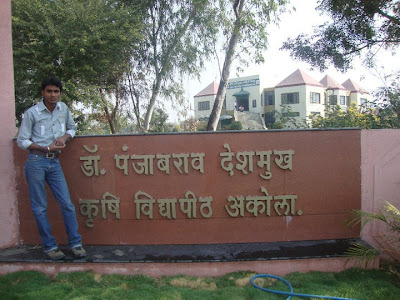Dr. Panjabrao Deshmukh Krishi Vidyapeeth, Akola..
Dr. Panjabrao Deshmukh Krishi Vidyapeeth,Akola was established on 20th October, 1969.This Agricultural University was named after the illustrious son of Vidarbha Dr. Panjabrao (alias Bhausaheb) Deshmukh, who was the Minister for Agriculture, Govt. of India.
Friday, August 31, 2012
Friday, March 23, 2012
important websites
Sunday, February 20, 2011
History of Akola
|
HISTORY
======== What constitutes Akola district at present was originally a part of the Nizam’s dominion assigned in 1853 to the East India Company in liquidation of the large debt due on account of arrears of pay on the Hyderabad contingent and as a security for future payment of that force. At that time Berar was divided into two districts, South and North. In 1857 Berar was reconstituted into two districts, West Berar with headquarters at Akola and East Berar with headquarters at Amravati. In 1903,the treaties of assignment were superseded by an agreement under which the Nizam leased Berar to the Government of India for an annual rent of 25 lakhs of rupees in perpetuity. The administration of Berar was transferred from Hyderabad to the then Chief Commissioner of Central Provinces. In 1864, when the district of Buldhana was constituted, a part of the west Berar district was transferred to Buldhana district. In 1875, again when the Washim district was created some parts were transferred and the district and tahsil boundaries were completely overhauled in 1905. Murtizapur tahsil was transferred from Amravati t Akola district and Khamgaon and Jalgaon tahsils were transferred from Akola to Buldhana district. The Washim district was broken and two tahsils of Washim and Mangrulpir were included in the newly constituted Akola district. There were no major changes in the boundaries of the district between 1911 and 1955. In 1956, with the Reorganisation of the States, the district was transferred from Madhya Pradesh to the then Bombay State and in 1960 it became a part of the State of Maharashtra. On First July 1998, Akola district was divided to form two new districts – Akola and Washim. Akola district now consists of Akola, Balapur, Patur, Barshitakli, Murtizjapur, Akot and Telhara talukas. The district headquarter is Akola. Akola city is located in north-central Maharashtra state, western India, on the Morna River. An important road and rail junction in the Purna River valley, it is a commercial centre trading chiefly in cotton. There are also textile and vegetable-oil industries. Akola is an important educational center with several colleges affiliated with the University of Amravati. Historical places in Akola A temple of Rajeshwar Fort Asadgadh A Sundarabai Khandelwal Tower ( 5 Floors) |
Gajanan Maharaj
Akola District At a Glance
|
Akola District At a Glance
|




